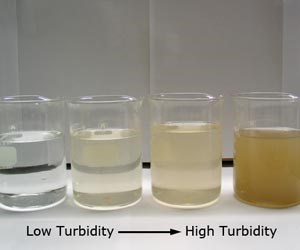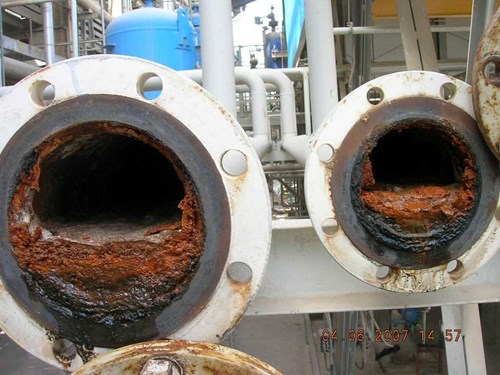Water Sanitation Part 2: Pre-Treating Water Before Sanitation


We often think of water quality from the standpoint of chemical properties, such as alkalinity, mineral elements, pH, etc. This information is important when determining acid injection rates and for selecting fertilizers that work best for a specific water source, but there is more to water than chemical properties. Water has suspended solids, such as sand and soil, and if the water is recycled, it can contain peat moss and growing medium. Water also has a biological component that includes many types of bacteria, fungi, algae and other organisms. Most of these microorganisms are benign or in some cases beneficial to the plants, but some may be plant pathogens, such as Pythium. Therefore there may be a need to sanitize irrigation water in order to eliminate root disease pathogens, especially with recycled water as well as pond, river and lake water.
Before water can be sanitized, the total suspended solids, water chemistry and biological load in the watering system have to be considered. These impact the efficacy of sanitizing agents and sanitation systems; therefore, a water source may require pre-treatment to adjust these properties so a water sanitation system has maximum impact on waterborne pathogens.
Total Suspended Solids
Total suspended solids refer to solid particles that are floating in a water source. The type of solids and the amount depend on where the water source comes from. Municipal and well water sources are relatively clean and contain a low percentage of total suspended solids, which come from mostly sand and soil. Often they are clean enough that they do not need to be filtered to remove solids. Pond, river and lake water tend to have sand, decomposing plant and animal matter, algae and microorganisms, giving them a higher percentage of total suspended solids and therefore greater need for filtration. However, recycled water that is stored in below ground tanks or ponds usually has the highest percentage of total suspended solids coming from growing medium, peat moss, algae, microorganisms and possibly some sand or soil.

It is important to know the amount of total suspended solids in the water as high levels will clog emitters, spaghetti tubes and equipment more rapidly. Also total suspended solids will use up sanitizing agents used in water, thus making them less effective for eliminating pathogens. In order to compensate for this, either sanitizing agents application rates need to be higher or the water needs to be filtered before being sanitized. Total suspended solids should be less than the EPA recommended maximum rate of 20 mg/L in water.
Suspended solids cloud water, reducing clarity and light transmission. This is a problem if water is being sanitized with UV radiation. If the radiation does not reach sections of the water, it will not be sanitized. As a guideline for using UV radiation for water sanitation, water should have a UV transmission rate of 75% or higher.
Chemical Properties
The chemical properties that influence the efficacy of some water sanitation systems include pH and soluble salts. The pH of the water should ideally be below 7.5 as it can reduce the activity of chlorine generated from chloride injectors and solubility of copper from copper ionization units. Water with a pH above 7.5 will require injection of higher rates of chlorine or copper to compensate for tie up due to the high water pH. A better solution is to inject acid into the water to reduce its pH to 7 or lower, so there is little tie up. Even water sources with very low alkalinity (<50 ppm CaCO3) can have a pH above 7.5, and yes, acid injection is still needed to reduce water pH when using chlorine generators or copper ionization units.
The amount of soluble salts in the water also influences the effectiveness of copper ionization. If the electrical conductivity (E.C.) of the water is below 0.2-0.3 mmhos/cm, too few copper ions are generated by a copper ionization system to attach to and kill pathogens, algae and other microorganisms. If a water source can have E.C. drop below 0.2-0.3 mmhos/cm, then find systems that can accommodate these drops or consider using ionization plates with larger surface areas. Also consider that as water E.C. fluctuates, it affects copper output. The more the water EC fluctuates, the more inconsistent the delivery of copper will be.
If the soluble salts in the water are high (>1.0 mmhos/cm), they use up oxidants, such as chlorine, activated peroxygen, ozone, etc., making them ineffective. Therefore, higher application rates of oxidants have to be used to effectively sanitize water.
Biological Properties: Water contains bacteria, algae and fungi. Not surprisingly, this microbial load is very high in recycled water as well as water coming from pond, river and lake sources. Well and municipal sources have lower microbial loads. If water has a high microbial load, then it can lead to rapid build-up of biofilm in water lines, spaghetti tubes and emitters, which can clog them. Biofilm also serves as a “reservoir” for algae and other microorganisms that can quickly populate the walls and floors of the greenhouse as well as the growing medium surface.
To determine the biological properties of the water, test for the total aerobic bacterial count. It is best to have less than 10,000 colony forming units per milliliter of water. Although not all microorganisms in the water are aerobic bacteria, their population generally reflects the population of other microorganisms in the water. Therefore if aerobic bacterial counts are high, so are the populations of other microorganisms in the water.

As stated, most microorganisms in water are harmless or beneficial; but some can be pathogenic. Sanitizing water to eliminate pathogens will also kill all other microorganisms in the water. If the microbial load in the water is high, then more sanitizing agent is needed to compensate. For example, when sanitizing with chlorine, most pathologists believe that having 2 ppm free chlorine in the water will kill Pythium and Phytophthora. In order to have 2 ppm free chlorine in the water, more chlorine needs to be added to eliminate existing microorganisms in the water, as well as account for loss from organic solids floating in the water and possibly high water pH.
The bottom line is that in order for water to be sanitized, it often needs to be pre-cleaned first, depending on the sanitation method. The first step for most sanitation systems, if needed, is to reduce total dissolved solids through filtering the water. Measure the total dissolved solids and, if you are using UV radiation to clean the water, also check the UV radiation transmission through the water. If this is not sufficient, then more filtering is required. Next, check the pH of the water; it is best for it to be below 7.5. Last, if the water has a high microbial population, you may need to “shock” (chlorine treatment) your irrigation system to remove the biofilm that may have built up. This will help reduce overall microbial population.
In the next and final article about water sanitation, we will discuss the pros and cons of each type of water sanitation system and offer suggestions as to which one may work best with your irrigation system. Remember that no water sanitation system works for every grower’s situation.
Sources:
- Meador, D.P. and P.R. Fisher. 2011. "Ready Research Results: How dirty is your water?" Greenhouse Grower, Jan 2011:62-63.
- C.C. Powell. 2001. "Are Your Plants Drinking Dirty Water?" Grower Talks 79(7)
- Wick, R.L., P.R. Fisher, and P.F. Harmon. 2011. "Biology of waterborne pathogens." OFA Bulletin Mar/Apr 2011 14-16